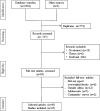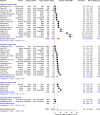Prevalence of overweight and obesity among African primary school learners: a systematic review and meta-analysis
- PMID: 31687173
- PMCID: PMC6819980
- DOI: 10.1002/osp4.355
Prevalence of overweight and obesity among African primary school learners: a systematic review and meta-analysis
Abstract
Introduction: The increasing trend in the global prevalence of childhood overweight and obesity presents a major public health challenge. This study reports the results of a systematic review and meta-analysis to estimate the prevalence of overweight and obesity among primary school learners residing in Africa according to the different body mass index criteria and population level characteristics.
Methods: A search of multiple databases was conducted to identify relevant research articles published between January 1980 and February 2017. Random effects models were used to pool prevalence data within and across population level characteristics after variance stabilization through arcsine transformation (PROSPERO registration number CRD42016035248).
Results: Data from 45 studies across 15 African countries, and comprising 92,379 and 89,468 participants for overweight and obesity estimates were included. Estimated overweight and obesity prevalence differed significantly across criteria: 10.5% [95% confidence interval, CI: 7.1-14.3] and 6.1% [3.4-9.7] by World Health Organization; 9.5% [6.5-13.0] and 4.0% [2.5-5.9] by International Obesity Task Force; and 11.5% [9.6-13.4] and 6.9% [5.0-9.0] by Centre for Diseases Control, respectively (p = 0.0027 for overweight; p < 0.0001 for obesity). Estimates were mostly higher in urban, and private schools, but generally similar by gender, major geographic regions, publication year and sample size. Substantial heterogeneity in the estimates across and within criteria were not always explained by major study characteristics.
Conclusion: Overweight and obesity are prevalent among African primary school learners, particularly those attending urban, and private schools. The results from this meta-analysis could be helpful in making informed decisions on childhood obesity prevention efforts in African countries.
Keywords: Africa; Meta‐analysis; Overweight; learners.
© 2019 The Authors. Obesity Science & Practice published by John Wiley & Sons Ltd, World Obesity and The Obesity Society.
Conflict of interest statement
No conflict of interest was declared.
Figures




References
-
- UNICEF , World Health Organization , World Bank Group . Levels and trends in child malnutrition. 2016:1‐8. 10.1016/S0266-6138(96)90067-4. - DOI
-
- Wabitsch M, Moss A, Kromeyer‐hauschild K. Unexpected plateauing of childhood obesity rates in developed countries. BMC Med 2014; 12: 17 http://www.biomedcentral.com/1741‐7015/12/17. - PMC - PubMed
Publication types
LinkOut - more resources
Full Text Sources
